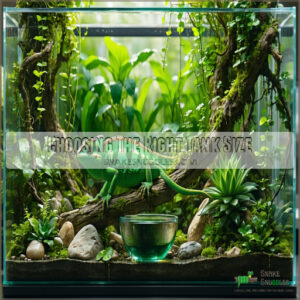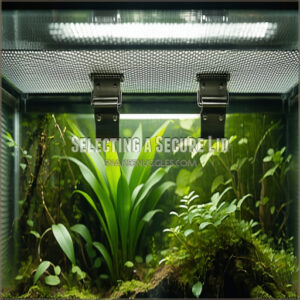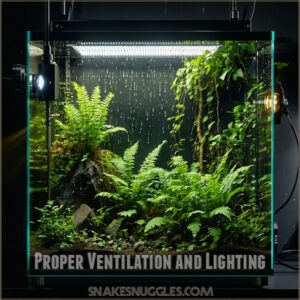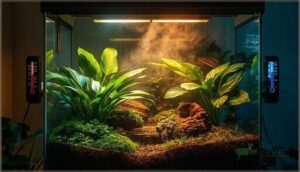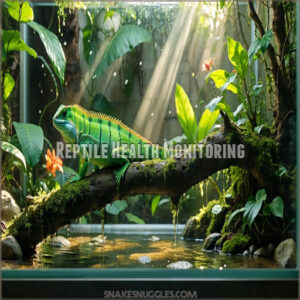This site is supported by our readers. We may earn a commission, at no cost to you, if you purchase through links.

Start with a tank that’s 1.5 times your pet’s adult size—bigger is better here, so plan for growth.
Secure it with a locking mesh lid to prevent any sneaky escapes.
Create temperature zones by placing a basking spot at 90-95°F and keeping the rest around 75-80°F.
Use UVB/UVA lighting for health and natural behavior.
Substrates like coconut fiber support humidity while decor like hiding spots and climbing branches encourage exploration.
Spot-clean daily, do deep cleans weekly, and replace substrate monthly.
Ready to fine-tune? Let’s tackle temperature gradients and humidity next!
Table Of Contents
- Key Takeaways
- Reptile Tank Setup
- Temperature and Humidity
- Substrate and Decor
- Cleaning and Maintenance
- Reptile Health Monitoring
- Frequently Asked Questions (FAQs)
- How to care for reptiles?
- How do I Keep my reptiles happy and healthy?
- What makes a good reptile habitat?
- How do you care for a captive reptile?
- Do Reptiles need a home?
- What is a substrate for a reptile?
- What are the housing requirements needed to properly care for reptiles?
- How often should you deep clean your reptile enclosure?
- What 5 basic things are needed to house a reptile?
- How do you disinfect reptile habitat leaves?
- Conclusion
Key Takeaways
- Keep the temperature gradient right by setting a basking spot at 90-95°F and maintaining a cooler zone around 75-80°F for proper thermoregulation.
- Spot-clean the tank daily, deep clean weekly, and replace the substrate monthly to maintain a clean and healthy environment.
- Use UVB/UVA lighting to support your reptile’s overall health, including vitamin D3 production and natural behaviors.
- Provide secure housing with a locking mesh lid, proper ventilation, and decor like hides and climbing structures to prevent escapes and encourage activity.
Reptile Tank Setup
You’ll need a tank that’s at least 1.5 times your reptile’s length and depth to guarantee they’ve got plenty of room to explore and thrive.
Once you’ve got the right size tank, you’ll want to focus on the essentials: a secure lid to prevent escapes, proper ventilation for airflow, and strategic placement of heating elements to create the perfect temperature zones for your scaly friend.
Choosing The Right Tank Size
Every reptile deserves the perfect space to thrive.
Your tank size choice can make or break your pet’s well-being.
Here’s what experienced keepers consider when selecting enclosure size:
- Measure habitat dimensions using the standard rule: tank length and depth should be 1.5x your reptile’s adult size
- Plan tank volume based on species needs – arboreal species need taller spaces
- Consider growth potential – adult enclosure size matters more than starter tanks
- Factor in extra space for temperature gradients
- Add room for enrichment items and natural behaviors.
For specific reptile needs, review this helpful terrarium size guide to understand the importance of a suitable terrarium size and how it affects your reptile’s adult size.
Selecting a Secure Lid
Now that you’ve got the right tank size, let’s lock down your reptile enclosure’s security.
A metal mesh lid with secure fasteners is your best bet for escape prevention.
Choose locking mechanisms that can handle determined explorers, and double-check that all edges fit snugly against your tank.
For added tank security, install secondary clips or locks – those little escape artists can be surprisingly crafty.
Regularly inspect your setup for potential escape vulnerabilities, addressing any gaps or weaknesses promptly, to ensure the reptile enclosure remains secure.
Proper Ventilation and Lighting
Now that your lid’s secure, let’s talk about lighting – your reptile’s window to a healthy life.
Your scaly friend needs both UVA and UVB lighting to thrive.
Set up UVB lighting to help with vitamin D3 production and calcium absorption, while UVA supports natural behaviors like feeding and movement.
You can find a variety of suitable reptile UVB lights online.
Choose ventilation types that maintain proper air flow without compromising temperature control or humidity levels.
Heater Placement and Safety
Smart heater placement can make or break your reptile’s comfort and safety .
Position your heat source to cover one-third of the enclosure, creating a proper thermal gradient for thermoregulation.
For ideal reptile care, consult an extensive snake cage heating guide.
Mount heating elements securely using UL-certified equipment and monitor temperatures with digital probes to prevent fire risks.
For 24-hour heating needs, ceramic emitters offer the safest temperature control while respecting your pet’s natural cycles.
Temperature and Humidity
You’ll need to keep your reptile’s temperature and humidity levels just right, as these two factors can make or break your pet’s health and happiness.
Managing these conditions isn’t rocket science – with a good thermometer, hygrometer, and the right setup, you’ll create the perfect environment for your scaly friend to thrive.
Ideal Temperature Ranges
Your reptile’s temperature gradient needs to be a perfect balancing act.
Keep the basking spot between 90-95°F for ideal thermoregulation , while maintaining ambient temperatures of 75-80°F in the cool zone.
This temperature control setup lets your scaly friend regulate their body heat naturally.
Create these thermal gradients using heat sources like ceramic emitters or heat mats, monitoring temperature levels daily.
Managing Humidity Levels
Mastering humidity control starts with understanding your scaly friend’s needs.
Your habitat’s moisture management toolkit should include strategically placed water bowls, fogging systems for tropical species, and humid hideouts with damp sphagnum moss.
For precise moisture levels, use ReptiBark or coconut fiber substrate to retain humidity.
Mist daily and add live plants for natural humidity through transpiration, creating your pet’s perfect moisture paradise.
Thermometers and Hygrometers
Getting temperature and humidity right isn’t guesswork—it’s science.
Thermometers and hygrometers are your go-to tools for precision.
- Choose digital models for more accurate readings.
- Calibrate them regularly because accuracy matters for temperature control.
- Use separate devices for each enclosure area to monitor variations.
Reliable digital readings guarantee your habitat’s perfect balance, keeping your reptile healthy and stress-free.
Creating a Temperature Gradient
Creating a temperature gradient is like setting up different "climate zones" in your reptile’s tank.
You need basking spots and cooler areas for thermoregulation.
Place heat sources strategically—left side for heat, right for cooler temps.
Use thermometers to fine-tune.
| Temperature Zone | Target Range | Example Heat Source | Adjustment Tips |
|---|---|---|---|
| Basking Spot | 85-95°F | Heat lamps | Use thermostats |
| Warm Zone | 80-85°F | Ceramic emitters | Adjust heater height |
| Cool Zone | 75-80°F | None | Keep ventilated |
| Nighttime Low | 70-75°F | Heat mats (if needed) | Lower wattage bulbs |
Substrate and Decor
Choosing the right substrate and decor keeps your reptile safe, comfortable, and stress-free.
From cozy hides to climbing branches, you’ll create both a functional and natural-looking environment for your pet.
Selecting The Right Substrate
Choosing the perfect reptile substrate isn’t one-size-fits-all.
Think about substrate options that fit your pet’s natural habitat and behavior.
Absorbent reptile substrate like coconut coir is great for humidity control, while reptile carpet makes substrate replacement easy.
Burrowers thrive with deeper layers, while simple materials like paper towels keep cleaning manageable.
Always prioritize material safety for your reptile’s comfort and health.
When selecting a substrate, consider the importance of proper reptile substrate to guarantee a healthy environment for your pet.
Safe and Toxic Materials
Your reptile’s safety starts with material safety.
Stick to reptile-safe options like coconut fiber or reptile carpet for bedding.
Avoid toxic substances such as cedar or pine, which release harmful chemicals.
Choose chemical-free, non toxic decor like untreated wood or natural rocks.
Always disinfect everything with reptile-friendly products to maintain a safe, chemical-free environment your pet can thrive in.
Decor for Climbing and Hiding
Snake enclosure decor isn’t just about aesthetics—it’s about making your pet feel at home.
Add climbing structures like branches or angled rock formations for activity, and include cave systems or snake hides to offer secure hiding places.
Branch arrangements double as reptile enrichment tools, encouraging natural behaviors, and thoughtful reptile habitat maintenance guarantees your scaly friend stays happy, stress-free, and active.
Substrate Replacement and Cleaning
Think of substrate replacement like a mini housecleaning ritual.
Stick to a cleaning schedule to keep your reptile safe and cozy.
For specific reptile substrate needs, explore various ball python substrate options.
- Daily: Handle waste management with spot checks.
- Weekly: Use cleaning tools for tank sanitation and light substrate removal.
- Monthly: Full substrate change—remove everything, clean thoroughly, and reset.
Regular upkeep means a healthier reptile habitat.
Keep it fresh!
Cleaning and Maintenance
Keeping your reptile’s habitat clean isn’t just about appearances—it’s essential for their health and comfort.
Regular maintenance, like daily spot cleaning and weekly deep cleans, prevents harmful bacteria and keeps their home safe and stress-free.
This maintenance is crucial for creating an environment that supports the well-being of your reptile.
Daily Spot Cleaning
Spot cleaning is your first line of defense for reptile hygiene.
Remove waste and leftover food daily to keep things fresh and safe.
Use reptile-safe tools and gloves for easy cleaning.
This quick habit reduces odors and also keeps your pet healthy.
| Task | Frequency | Tools Needed | Time Required | Benefits |
|---|---|---|---|---|
| Waste removal | Daily | Tongs, gloves | 5 minutes | Prevents bacteria |
| Food cleanup | Daily | Paper towels | 3 minutes | Avoids pests |
| Water bowl refresh | Daily | Clean sponges | 2 minutes | Keeps water clean |
| Surface wipe | Daily | Safe disinfectant | 5 minutes | Limits contamination |
| Spot substrate check | Daily | Hands/tongs | 2 minutes | Maintains hygiene |
The provided table outlines the daily tasks necessary for maintaining a clean and healthy environment for your reptile, including waste removal, food cleanup, water bowl refresh, surface wipe, and spot substrate check.
Weekly Deep Cleaning
Once daily spot cleaning’s done, it’s time for a deeper scrub.
Weekly cleaning means removing the substrate, decorations, and waste entirely, use reptile-safe cleaning tools for tank sanitation and waste removal.
Rinse everything thoroughly and inspect for buildup, a consistent habitat cleaning schedule keeps your reptile happy and healthy.
Trust me, a clean enclosure makes a noticeable difference!
Disinfecting Surfaces
Disinfection keeps bacteria under control and your reptile safe.
Stick to a simple cleaning routine:
- Remove decorations and wipe surfaces with a reptile-safe disinfectant.
- Scrub stubborn spots using soft brushes and cleaning supplies.
- Let surfaces dry completely to avoid residue.
- Disinfect water bowls separately.
- Follow your habitat cleaning schedule for consistent sanitation.
Clean spaces lead to healthy, happy reptiles!
Replacing Substrate Regularly
A dirty substrate doesn’t just smell bad—it messes with your reptile’s health.
Stick to a monthly substrate change or more often for crowded enclosures.
The correct snake housing substrate is essential for reptile health.
Regular substrate removal prevents bacteria buildup and boosts tank sanitation.
Always pick safe materials during habitat renewal.
| Task | Frequency | Purpose | Tip |
|---|---|---|---|
| Spot clean | Daily | Waste management | Use gloves for safety |
| Substrate removal | Weekly/Monthly | Reptile safety & health | Stick to your cleaning schedule |
| Deep clean tank | Monthly | Complete habitat maintenance | Use reptile-safe cleaner |
| Renew decor | Bi-Monthly | Enrichment & hygiene | Mimic natural environments |
Reptile Health Monitoring
Keeping an eye on your reptile’s health is key to catching problems early and ensuring they stay happy and active.
By monitoring their behavior, weight, and physical condition, you’ll spot changes that might need attention before they become serious, which is crucial for maintaining their overall well-being.
Recognizing Signs of Good Health
A healthy reptile is like a well-tuned instrument—everything works in harmony.
Watch for bright eyes, smooth skin, and steady weight as key health indicators.
Regular eating and active reptile behavior are signs you’re on track.
Don’t skip weight monitoring; even slight drops might signal stress or illness, and small changes in body condition can mean big issues, so stay sharp.
Monitoring Behavior and Physical State
Spotting issues early comes down to knowing your reptile’s quirks.
Watch for common signals in reptile body language or physical changes.
Odd behavioral patterns? Red flag.
Use reptile health checks like daily observations to catch problems before they snowball.
- Sudden weight loss or gain
- Hiding more than usual
- Strange skin changes
- Erratic movements
- Loss of appetite
Regular Veterinary Visits
Sometimes, the best thing you can do for your pet reptile is schedule regular vet checkups.
Vet care tips like routine health screenings catch issues early, saving you stress later, it’s like giving your pet a tune-up, ensuring they thrive longer in your care.
For further guidance on reptile care, consult thorough reptile health advice, and trust these preventive measures, as exotic pet vets can offer personalized advice for reptile health.
Exotic pet vets can offer personalized advice, and by following these tips, you are ensuring your pet receives the best possible care, which is essential for their overall well-being.
Adjusting Care Routines as Needed
In reptile care, flexibility is key because their needs can shift over time.
Through regular reptile observation, adjust routines based on health monitoring or environmental changes.
Here’s how to stay on top of it:
- Research species-specific updates to refine care.
- Monitor behavior to catch stress or illness signs early.
- Adjust habitats as reptiles grow and seasons change.
This approach allows for adaptive care that meets the evolving needs of reptiles, ensuring a healthy and thriving environment through regular observation.
Frequently Asked Questions (FAQs)
How to care for reptiles?
Think of your reptile as a living puzzle—each care step fits perfectly to complete their well-being.
Provide proper lighting, heating, habitat, and diet, while cleaning regularly and watching for signs of stress or illness.
How do I Keep my reptiles happy and healthy?
Keep your reptiles happy and healthy by providing proper habitat temperatures, UVB lighting, and humidity.
Feed a balanced diet, make certain of regular tank cleaning, and add climbing decor.
Monitor their behavior closely—it’s their way of communicating with you through behavior.
What makes a good reptile habitat?
Did you know 50% of reptile illnesses stem from poor habitats.
A great reptile home needs proper heating, UVB lighting, secure space, ventilation, and species-specific décor to mimic the wild and keep them thriving.
How do you care for a captive reptile?
You’ll nail reptile care by setting up their tank right, keeping them fed with a balanced diet, and maintaining their habitat with daily cleaning, proper lighting, and regular health checks like a pro.
This single sentence encompasses all necessary instructions for reptile care, and as such, does not require further separation for clarity.
Do Reptiles need a home?
A reptile’s home is their kingdom—it’s where they thrive.
Without proper housing, they can’t regulate temperature, feel secure, or mimic natural behaviors.
A well-set habitat keeps them healthy, happy, and stress-free.
What is a substrate for a reptile?
A substrate is the bedding or ground material in your reptile’s tank.
It impacts comfort, humidity, and cleanliness.
Choose safe options like coconut fiber, reptile carpet, or paper towels, avoiding harmful materials like cedar or pine, for a safe and healthy environment with the right humidity.
What are the housing requirements needed to properly care for reptiles?
A proper setup means giving your reptile enough space, secure enclosures, good ventilation, temperature control, UVB lighting, and species-specific decor.
Always match the environment to their natural habitat for health and happiness.
How often should you deep clean your reptile enclosure?
It’s funny how easy it’s to forget deep cleaning—do it monthly.
Remove all substrate, decorations, and waste.
Scrub surfaces with reptile-safe cleaners, rinse thoroughly, and refresh everything to keep your buddy thriving.
What 5 basic things are needed to house a reptile?
You’ll need the right enclosure, a secure lid, proper heating and lighting, suitable substrate, and safe decorations.
Each piece creates a cozy, escape-proof home where your reptile can thrive and feel at ease.
How do you disinfect reptile habitat leaves?
Clean reptile habitat leaves by soaking them in warm water mixed with reptile-safe disinfectant.
Scrub gently with a soft brush, rinse thoroughly, and let them air-dry completely before placing them back in the enclosure.
Conclusion
Think of your reptile’s habitat like their castle—it’s where adventures happen and comfort rules.
By sticking to this reptile habitat maintenance guide, you’ll guarantee their home stays safe, clean, and perfectly suited to their needs.
From temperature zones to daily cleaning, every detail matters for their health and happiness.
Once you’ve mastered these steps, your scaly friend will thrive, exploring their kingdom like the ruler they are.
Keep it simple, stay consistent, and watch your pet flourish!
- https://www.petmd.com/reptile/slideshows/care/reptile-terrarium-checklist
- https://reptilesupershow.com/essential-reptile-habitat-setup-guide-tips/
- https://talis-us.com/blogs/news/the-ultimate-guide-to-creating-a-reptile-habitat
- https://www.merckvetmanual.com/all-other-pets/reptiles/providing-a-home-for-a-reptile
- https://www.zillarules.com/articles/how-to-set-up-a-reptile-tank

